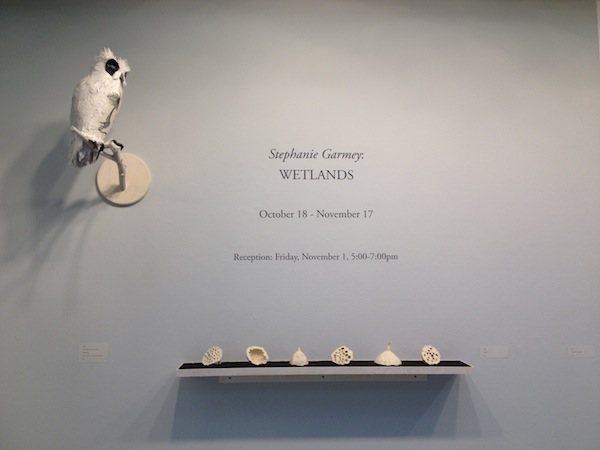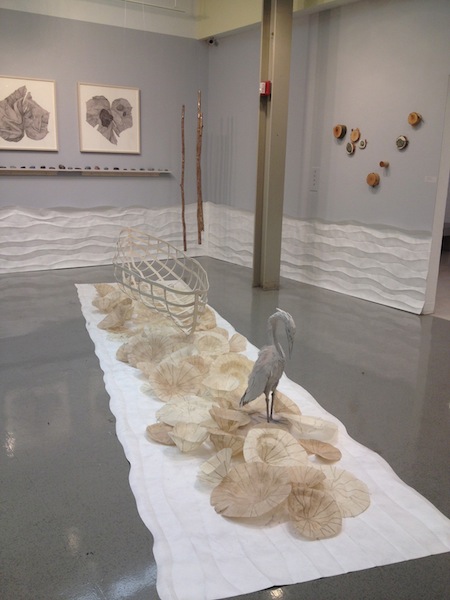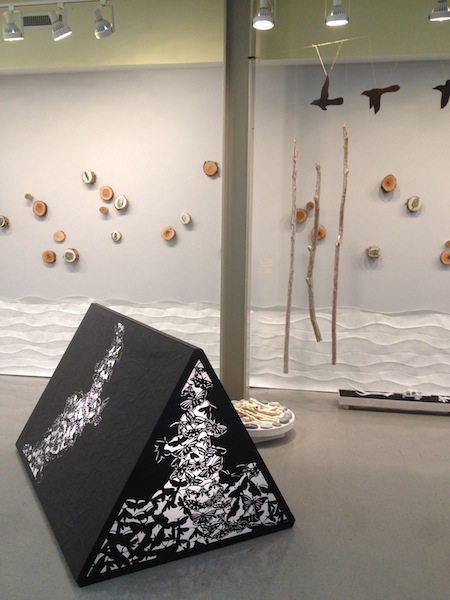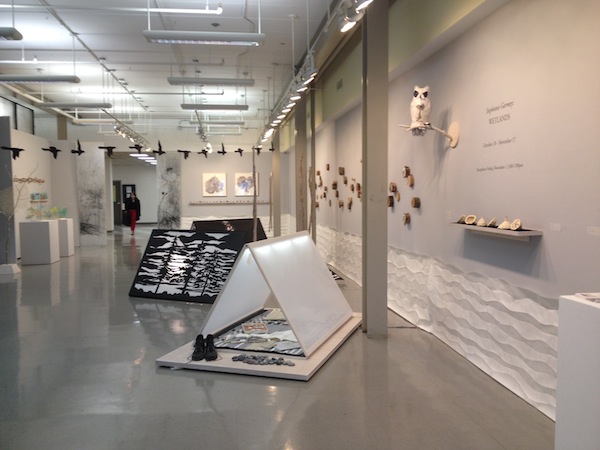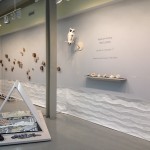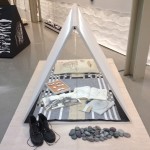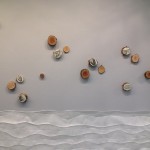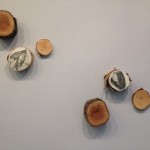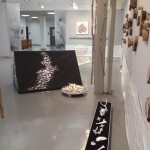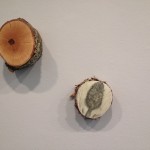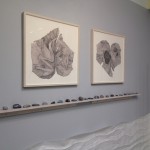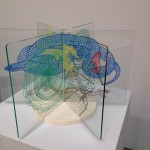Treasured river rocks, seedpods, feathers, woodland creatures, reverently rendered graphite drawings encased in wood and wax. In Wetlands, a solo exhibit at MICA, Stephanie Garmey creates a multi-sensory environment through drawn and sculptural installation. The exhibit is an opportunity to retreat and transport yourself out of the city to the wetlands through the eyes of the artist. Collected remains of bone, rock, and plant are fabricated with care and attention to detail in ceramic and paper clay that surprises the viewer with their metaphoric and actual likeness.
In the center, a hand-woven reed canoe is suspended over delicately shaped lotus leaves made of thin paper. A regal, sculptural heron made of hand cut paper, wood, and wax invokes a feeling of stillness, anticipation, and halted time. The sounds of chirping crickets, footsteps, and a distant night train subtly fill the gallery space. Every surface is considered, including folded paper lining the lower portion of the walls which mimics the rhythm and movement of water. Overhead, a sequential line of a silhouetted bird in flight draws the eye through the space. An overall use of neutral tones dominates and unifies the main section of the installation in eggshell, grays, black, and wood. This hushed palette creates a feeling of peacefulness and dusk, of seasons passed.
Mounted on the wall in scattered clusters, dozens of cross-sections of a tree serve as surfaces for exquisitely rendered graphite drawings in wax. They depict a small dead mouse, a fallen bird, an empty turtle shell, a pair of found feathers, and open seed pods where the beauty of the form is captured by the artist, but the life force relinquished. Many of the circular sections are simply rubbed with wax and left blank for the viewer to consider the texture of curling bark, the cracks and intricate lines of the wood.
A gradation of bright colors painted on the stubby ends of short branches undulating in height protrude from another wall, creating a lively movement. The piece is reminiscent of a gust of wind, or looking up through tree branches seeing bits of bright sky, or the flash of a red cardinal. Glass book pages mounted on the wall show ironic and contrasting images of animal and human. “Deer Watching” becomes the deer watching the people. Nostalgic cars, campers, and a bear outside a simple tent are humorous and almost kitch. Contour lined wide-eyed animals in singular saturated colors are featured in two unusual books where lines and form overlap through the fanned, spoke-like transparent glass pages. Beaver, frog, and snake are juxtaposed with ferns, leaves, and tree rings.
At first glance, dozens of smooth, tumbled rocks in gray, heathered purple, and faded denim blue tones with white linear markings appear to be a collection of found treasures, but are curiously crafted by the artist of clay, watercolor, and wax. The objects are lined along the wall on a shallow shelf, and clustered throughout, with space in between to consider their individuality and likenesses.
Deer bones and hollow seed pods, both past their prime and usefulness, are also arranged as specimens in an organic arrangement, but were also fabricated by the artist out of clay. The play between the the object’s fragility, and realistic likeness contrasts with their implied vitality, and with the past lives of the objects they depict. Garmey defines the space on the far side of the gallery with two very tall scrolls of encaustic wax drawings of layers of marsh grasses, pods, with sweeping, gestural lines sprinkled with a subtle use of gold leaf and hints of blue. They create a lush, vibrant celebration of the subject matter in a different way than the sparse, smooth object fabrications.
At the very center of the gallery, three illuminated tents fill the foreground of the installation space. One white, triangular tent contains a number of objects bearing the consideration, care, and handwork of the artist in every corner. The other two are lantern-like, with black cut paper sealing the entire triangle with silhouetted imagery of clustered moths in flight, and landscape of trees and sky. The white tent is quietly playful, yet pristine in its coloration and size. It functions as a personal retreat for one, complete with pure white, delicately small prayer flags hung inside. It contains a meticulously hand embroidered pillow with plant imagery and a woven felt blanket, carefully tucked. The viewer can peer inside as a voyeur on both ends and through the tightly stretched organza.
The intimacy of the space is further developed by three open sketchbooks. One is open to a full spread of dark, graphite renderings of vintage station wagons with hitched trailers. The renderings come off as nostalgic of family camping trips. Two other open handmade books reveal topographical hand drawn maps and the tracings of wood rings. A specimen collection of moths simply rendered in graphite on paper are pinned to a plain wooden box. Outside the tent, a whimsically stitched pair of boots of thick dark woolen cloth, with worn grommets, and loosened laces further implies who this tent dweller could be.
In Wetlands, Stephanie Garmey creates a sense of the depth in treasured natural spaces through honest reproduction and pristine form. Unlike other artists, who emphasize the strife and endangerment of the natural environment, Garmey’s created spaces are reverent, with minimal human presence. She draws on a personal history of enjoying and exploring the outdoors as a child and an adult, and collecting natural objects as inspiration for her work. These memorable installations are a collection of an artist’s lifetime spent in harmony and careful observation of this specific ecosystem conveying a sense of place, lifecycle, and interconnection.
………………………..
Wetlands by Stephanie Garmey is on display through November 17, 2013 in MICA’s Bunting Center, Pinkard Gallery.
Author Jill Gordon is an urban explorer, fiber artist, and writer, and can be contacted at [email protected].



